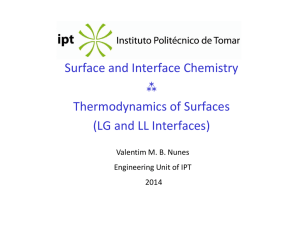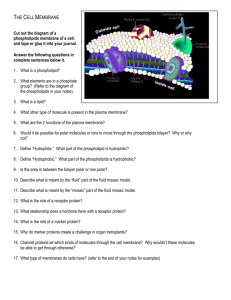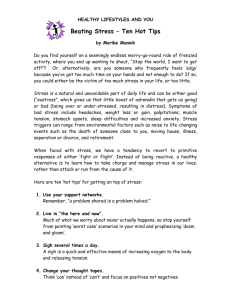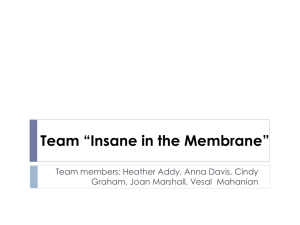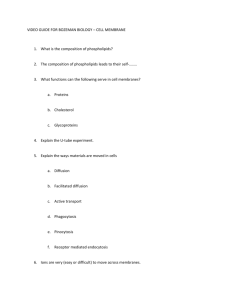surface tension
advertisement
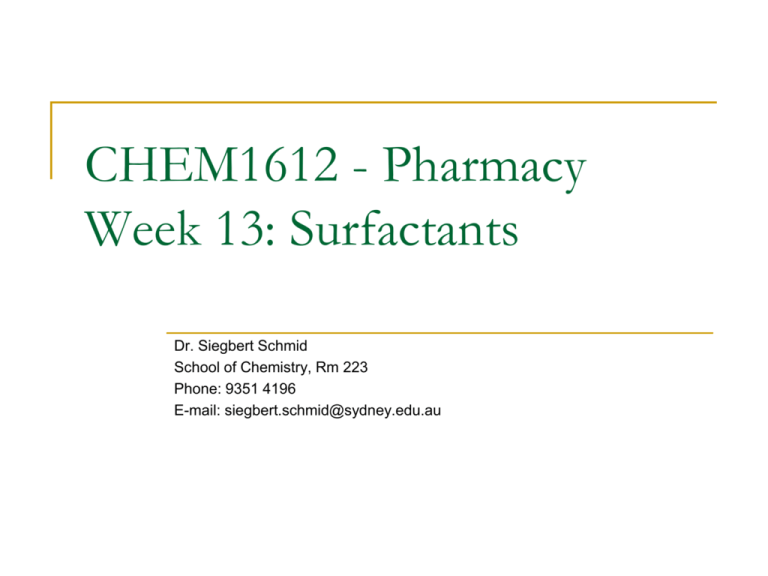
CHEM1612 - Pharmacy Week 13: Surfactants Dr. Siegbert Schmid School of Chemistry, Rm 223 Phone: 9351 4196 E-mail: siegbert.schmid@sydney.edu.au Unless otherwise stated, all images in this file have been reproduced from: Blackman, Bottle, Schmid, Mocerino and Wille, Chemistry, John Wiley & Sons Australia, Ltd. 2008 ISBN: 9 78047081 0866 Surface Tension and Surfactants Blackman, Bottle, Schmid, Mocerino & Wille: Chapters 7, 22 self-cleaning surfaces ‘lotus effect’ goretex, teflon... Lecture 37 - 3 Hi-tech: printing Need to understand, and be able to control both the breakup of liquid jets into small droplets, and the subsequent interaction of the droplets with the target. inkjet Lecture 37 - 4 Surface Tension Liquid/air interface Any interface (liquid/liquid, liquid/solid, liquid/gas, etc.) has an associated surface energy. To understand, think of a liquid droplet: the molecules in the interior of the droplet are surrounded by other molecules of the same kind. However, those at the liquid surface are subject to attractions only from the sides and from below. Bulk liquid The effect of this uneven pull on the surface molecules is to draw them into the body of the droplet. Therefore a droplet assumes a spherical shape. The sphere is the geometry with minimum surface area. The liquid appears to have a skin over the surface. BASF Lecture 37 - 5 Surface Tension Herminghaus, 2003. Molecules on the surface would rather be in the bulk. To increase the surface area, molecule within a phase must move from the bulk to the surface, by breaking some attractive interactions, which requires energy. The resistance of a medium to an increase in its surface area is called the surface tension of the medium (can be solid or liquid). The surface tension is the energy required to increase the surface area by a unit amount (units J/m2 = N/m). Lecture 37 - 6 Surface Tension of Liquids The stronger the forces between the molecules, the higher the surface tension. Polar solvents like water tend to have fairly high surface tension because they interact strongly by H bonding. hydrogen bond donor hydrogen bond acceptor H bond Blackman Figure 6.32 Lecture 37 - 7 Surfactants Surface-active agents: any molecule that is amphiphilic, i.e with portions that are hydrophobic (= water hating, therefore lipophilic, fat loving) and hydrophilic (= lipophobic) portions. Hydrophobic tail hydrophilic head McGraw Hill, 2006. Figure from Silberberg, “Chemistry”, Surfactants decrease the surface tension of water by adsorbing at the water/air interface and disrupting the H bonds. Soaps and detergents are surfactants, often salts of fatty acids. Lecture 37 - 8 Demo: Adding Surfactant to Water A beaker full of water We add fine sulphur powder, whose weight can be supported by the water/air interface due to water surface tension g0. Then we add soap, which decreases the surface tension of water, and so the powder cannot be supported anymore. Water Surface tension g0 Mineral oil Water Olive oil Water Lecture 37 - 9 Soap Much of what we call dirt is non-polar. Grease for example consists of long chain hydrocarbons. However water, the solvent most commonly available to us is very polar and will not dissolve ‘greasy dirt’ Soap can be viewed as an emulsifying agent, since it acts to suspend the normally incompatible grease in the water. Because of this ability to assist water in ‘wetting’ and suspending nonpolar materials, soap is called a wetting agent or surfactant. Lecture 37 - 10 Self-Assembly: Micelles As a surfactant is added to water, the molecules adsorb at the air/liquid interface, but otherwise are free in solution. Above a certain conc., they spontaneously aggregate into micelles. This occurs at the CRITICAL MICELLE CONCENTRATION (c.m.c.) at the c.m.c. Reduced Interaction of chains with water Hydrophobic interactions between chains A “soap” solution contains both individual surfactants dispersed in water and aggregates (micelles). Thus a soap-water mixture is a suspension of micelles in water. Because the relatively large micelles scatter light (colloidal), soapy water looks cloudy. Lecture 37 - 11 Detergents Artificial soaps are known as detergents Most widely used class of detergents used are the alkylbenzene sulfonates (with –SO3- group) Fabric softener are often quaternary ammonium salts Lecture 37 - 12 “Hard” and “Soft” Water “Hard water” contains high amounts of divalent ions such as Ca2+, Mg2+, Fe2+. The disadvantage of soaps is that the anions form precipitates with the cations like Ca2+ and Mg2+. This forms a scum and reduces the soaps’ efficiency. Ca2+ + 2 C17H35COONa(aq) → (C17H35COO)Ca (s) + 2 Na+ Lecture 37 - 13 Revision Lecture - Thursday If you have questions send them to me by e-mail and I will incorporate relevant material. We will not cover any new material. Everything we have covered in lectures (not lecture notes) is examinable, as is the chemistry relating to your laboratory work. Lecture 37 - 14 Lipids are broadly defined as any amphiphilic, naturallyoccurring molecules. The term is also used more specifically to refer to fatty-acids and their derivatives, as well as other fat-soluble sterol-containing metabolites such as cholesterol. fats phospholipids (with a organophosphate group) waxes steroids Hydrophobic tail Fats that are esters of glycerol are called triglycerides. Soaps are produced by saponification: the hydrolysis of lipids to glycerol and salts of fatty acids (carboxylate salts = soaps) by KOH or NaOH. Figure from Silberberg, “Chemistry”, McGraw Hill, 2006. Lipids Polar-ionic head KOH carboxylate salt glycerol Lecture 37 - 15 Self-Assembly in Lipids In the self-assembly of surfactants and lipids, hydrophobic interactions are important Head group Tail group A lipid is an amphiphilic molecule, but rarely exists as a monomer. air water monolayer Micelle Inverse micelle (in nonpolar solvent) Lipid bilayer Lecture 37 - 16 Phospholipids Phospatidylcholine hydrophilic Apolar hydrophobic a bilayer Long hydrophobic tails Polar head Phospholipids are similar in structure to fats in that they are esters of glycerol. However unlike fats they contain only two fatty acids. The third ester linkage involves a phosphate group, which gives phospholipids two distinct parts: long non-polar tail polar substituted phosphate “head” Phospholipids tend to form bilayers in aqueous solution with the tails in the interior and the polar heads interfacing with the polar water molecules. Lecture 37 - 17 Self-assembly in Phospholipids Phospholipids prefer to form bilayer structures in aqueous solution because their two fatty acid chains do not pack well; Phospholipids can form either unilamellar vesicles (liposomes) or multilamellar vesicles; unilamellar vesicles (liposomes); highly stable, can be used as drug and enzyme delivery systems multilamellar vesicles Lecture 37 - 18 McGraw Hill, 2006. Figure from Silberberg, “Chemistry”, Cell Membrane Ca. 8 nm thick A cell membrane is a bilayer of phospholipids, embedded with various proteins, and protects the cell from the extracellular fluid that surrounds it. Allows nutrients and other necessary chemicals to enter the cell and waste products to leave, through the proteins that act as pumps, gates, and channels. Biological membranes are sites of biochemical reactions that include photosynthesis, electron transfer, oxidative phosphorylation; Facilitate cell motion; provide cell recognition and cell fusion. Lecture 37 - 19 Fluid Mosaic Model The most widely accepted model of this transfer of nutrients and waste is called the fluid mosaic mode, proposed by S. J. Singer and G. L. Nicolson, in 1972. The phospholipid bilayer is a fluid matrix: the bilayer is a twodimensional solvent, lipids and proteins can undergo rotational and lateral movement Small uncharged molecules such as water, oxygen and carbon dioxide diffuse freely through the bilayer, while other substances pass through “gates and passages” provided by specific proteins embedded in the membrane. McGraw Hill, 2006. Figure from Silberberg, “Chemistry”, Lecture 37 - 20 You should now be able to explain the molecular origin of surface tension understand the chemical nature and action of surfactants and detergents, and the process of self-assembly describe the function and chemical structure of biological membranes Lecture 37 - 21
